
The homepage of Stark Industries Solutions.
Two weeks before Russia invaded Ukraine in February 2022, a large, mysterious new Internet hosting firm called Stark Industries Solutions materialized and quickly became the epicenter of massive distributed denial-of-service (DDoS) attacks on government and commercial targets in Ukraine and Europe. An investigation into Stark Industries reveals it is being used as a global proxy network that conceals the true source of cyberattacks and disinformation campaigns against enemies of Russia.
At least a dozen patriotic Russian hacking groups have been launching DDoS attacks since the start of the war at a variety of targets seen as opposed to Moscow. But by all accounts, few attacks from those gangs have come close to the amount of firepower wielded by a pro-Russia group calling itself “NoName057(16).”
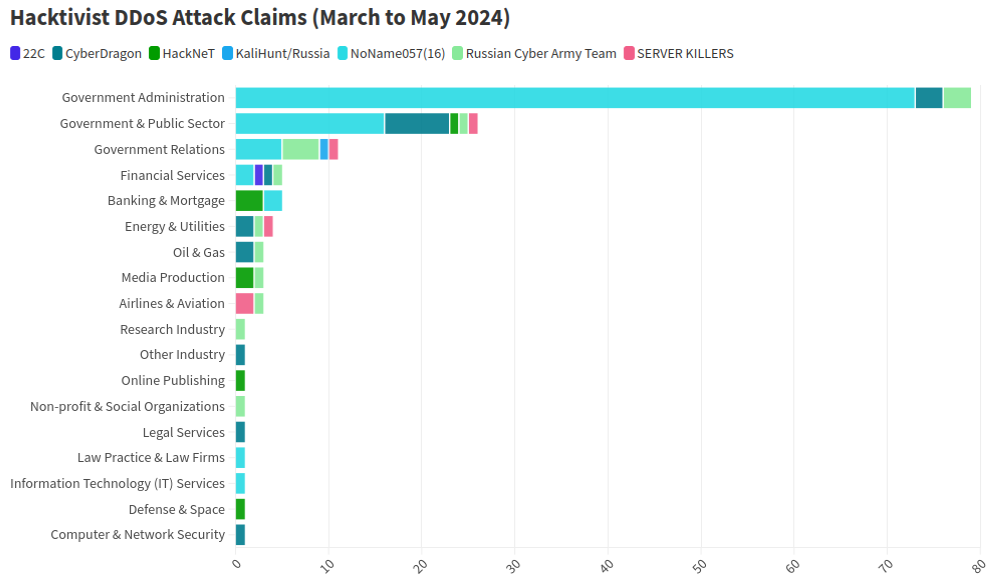
This graphic comes from a recent report from NETSCOUT about DDoS attacks from Russian hacktivist groups.
As detailed by researchers at Radware, NoName has effectively gamified DDoS attacks, recruiting hacktivists via its Telegram channel and offering to pay people who agree to install a piece of software called DDoSia. That program allows NoName to commandeer the host computers and their Internet connections in coordinated DDoS campaigns, and DDoSia users with the most attacks can win cash prizes.

The NoName DDoS group advertising on Telegram. Image: SentinelOne.com.
A report from the security firm Team Cymru found the DDoS attack infrastructure used in NoName campaigns is assigned to two interlinked hosting providers: MIRhosting and Stark Industries. MIRhosting is a hosting provider founded in The Netherlands in 2004. But Stark Industries Solutions Ltd was incorporated on February 10, 2022, just two weeks before the Russian invasion of Ukraine.
Security experts say that not long after the war started, Stark began hosting dozens of proxy services and free virtual private networking (VPN) services, which are designed to help users shield their Internet usage and location from prying eyes.
Proxy providers allow users to route their Internet and Web browsing traffic through someone else’s computer. From a website’s perspective, the traffic from a proxy network user appears to originate from the rented IP address, not from the proxy service customer.

These services can be used in a legitimate manner for several business purposes — such as price comparisons or sales intelligence — but they are also massively abused for hiding cybercrime activity because they can make it difficult to trace malicious traffic to its original source.
What’s more, many proxy services do not disclose how they obtain access to the proxies they are renting out, and in many cases the access is obtained through the dissemination of malicious software that turns the infected system into a traffic relay — usually unbeknownst to the legitimate owner of the Internet connection. Other proxy services will allow users to make money by renting out their Internet connection to anyone.
Spur.us is a company that tracks VPNs and proxy services worldwide. Spur finds that Stark Industries (AS44477) currently is home to at least 74 VPN services, and 40 different proxy services. As we’ll see in the final section of this story, just one of those proxy networks has over a million Internet addresses available for rent across the globe.
Raymond Dijkxhoorn operates a hosting firm in The Netherlands called Prolocation. He also co-runs SURBL, an anti-abuse service that flags domains and Internet address ranges that are strongly associated with spam and cybercrime activity, including DDoS.
Dijkxhoorn said last year SURBL heard from multiple people who said they operated VPN services whose web resources were included in SURBL’s block lists.
“We had people doing delistings at SURBL for domain names that were suspended by the registrars,” Dijkhoorn told KrebsOnSecurity. “And at least two of them explained that Stark offered them free VPN services that they were reselling.”
Dijkxhoorn added that Stark Industries also sponsored activist groups from Ukraine.
“How valuable would it be for Russia to know the real IPs from Ukraine’s tech warriors?” he observed.
Richard Hummel is threat intelligence lead at NETSCOUT. Hummel said when he considers the worst of all the hosting providers out there today, Stark Industries is consistently near or at the top of that list.
“The reason is we’ve had at least a dozen service providers come to us saying, ‘There’s this network out there inundating us with traffic,'” Hummel said. “And it wasn’t even DDoS attacks. [The systems] on Stark were just scanning these providers so fast it was crashing some of their services.”
Hummel said NoName will typically launch their attacks using a mix of resources rented from major, legitimate cloud services, and those from so-called “bulletproof” hosting providers like Stark. Bulletproof providers are so named when they earn or cultivate a reputation for ignoring any abuse complaints or police reports about activity on their networks.
Combining bulletproof providers with legitimate cloud hosting, Hummel said, likely makes NoName’s DDoS campaigns more resilient because many network operators will hesitate to be too aggressive in blocking Internet addresses associated with the major cloud services.
“What we typically see here is a distribution of cloud hosting providers and bulletproof hosting providers in DDoS attacks,” he said. “They’re using public cloud hosting providers because a lot of times that’s your first layer of network defense, and because [many companies are wary of] over-blocking access to legitimate cloud resources.”
But even if the cloud provider detects abuse coming from the customer, the provider is probably not going to shut the customer down immediately, Hummel said.
“There is usually a grace period, and even if that’s only an hour or two, you can still launch a large number of attacks in that time,” he said. “And then they just keep coming back and opening new cloud accounts.”
Stark Industries is incorporated at a mail drop address in the United Kingdom. UK business records list an Ivan Vladimirovich Neculiti as the company’s secretary. Mr. Neculiti also is named as the CEO and founder of PQ Hosting Plus S.R.L. (aka Perfect Quality Hosting), a Moldovan company formed in 2019 that lists the same UK mail drop address as Stark Industries.

Ivan Neculiti, as pictured on LinkedIn.
Reached via LinkedIn, Mr. Neculiti said PQ Hosting established Stark Industries as a “white label” of its brand so that “resellers could distribute our services using our IP addresses and their clients would not have any affairs with PQ Hosting.”
“PQ Hosting is a company with over 1,000+ of [our] own physical servers in 38 countries and we have over 100,000 clients,” he said. “Though we are not as large as Hetzner, Amazon and OVH, nevertheless we are a fast growing company that provides services to tens of thousands of private customers and legal entities.”
Asked about the constant stream of DDoS attacks whose origins have traced back to Stark Industries over the past two years, Neculiti maintained Stark hasn’t received any official abuse reports about attacks coming from its networks.
“It was probably some kind of clever attack that we did not see, I do not rule out this fact, because we have a very large number of clients and our Internet channels are quite large,” he said. “But, in this situation, unfortunately, no one contacted us to report that there was an attack from our addresses; if someone had contacted us, we would have definitely blocked the network data.”
DomainTools.com finds Ivan V. Neculiti was the owner of war[.]md, a website launched in 2008 that chronicled the history of a 1990 armed conflict in Moldova known as the Transnistria War and the Moldo-Russian war.

An ad for war.md, circa 2009.
Transnistria is a breakaway pro-Russian region that declared itself a state in 1990, although it is not internationally recognized. The copyright on that website credits the “MercenarieS TeaM,” which was at one time a Moldovan IT firm. Mr. Neculiti confirmed personally registering this domain.
The data breach tracking service Constella Intelligence reports that an Ivan V. Neculiti registered multiple online accounts under the email address dfyz_bk@bk.ru. Cyber intelligence firm Intel 471 shows this email address is tied to the username “dfyz” on more than a half-dozen Russian language cybercrime forums since 2008. The user dfyz on Searchengines[.]ru in 2008 asked other forum members to review war.md, and said they were part of the MercenarieS TeaM.
Back then, dfyz was selling “bulletproof servers for any purpose,” meaning the hosting company would willfully ignore abuse complaints or police inquiries about the activity of its customers.
DomainTools reports there are at least 33 domain names registered to dfyz_bk@bk.ru. Several of these domains have Ivan Neculiti in their registration records, including tracker-free[.]cn, which was registered to an Ivan Neculiti at dfyz_bk@bk.ru and referenced the MercenarieS TeaM in its original registration records.
Dfyz also used the nickname DonChicho, who likewise sold bulletproof hosting services and access to hacked Internet servers. In 2014, a prominent member of the Russian language cybercrime community Antichat filed a complaint against DonChicho, saying this user scammed them and had used the email address dfyz_bk@bk.ru.
The complaint said DonChicho registered on Antichat from the Transnistria Internet address 84.234.55[.]29. Searching this address in Constella reveals it has been used to register just five accounts online that have been created over the years, including one at ask.ru, where the user registered with the email address neculitzy1@yandex.ru. Constella also returns for that email address a user by the name “Ivan” at memoraleak.com and 000webhost.com.
Constella finds that the password most frequently used by the email address dfyz_bk@bk.ru was “filecast,” and that there are more than 90 email addresses associated with this password. Among them are roughly two dozen addresses with the name “Neculiti” in them, as well as the address support@donservers[.]ru.
Intel 471 says DonChicho posted to several Russian cybercrime forums that support@donservers[.]ru was his address, and that he logged into cybercrime forums almost exclusively from Internet addresses in Tiraspol, the capital of Transnistria. A review of DonChicho’s posts shows this person was banned from several forums in 2014 for scamming other users.
Cached copies of DonChicho’s vanity domain (donchicho[.]ru) show that in 2009 he was a spammer who peddled knockoff prescription drugs via Rx-Promotion, once one of the largest pharmacy spam moneymaking programs for Russian-speaking affiliates.
Mr. Neculiti told KrebsOnSecurity he has never used the nickname DonChicho.
“I may assure you that I have no relation to DonChicho nor to his bulletproof servers,” he said.
Below is a mind map that shows the connections between the accounts mentioned above.
Earlier this year, NoName began massively hitting government and industry websites in Moldova. A new report from Arbor Networks says the attacks began around March 6, when NoName alleged the government of Moldova was “craving for Russophobia.”
“Since early March, more than 50 websites have been targeted, according to posted ‘proof’ by the groups involved in attacking the country,” Arbor’s ASERT Team wrote. “While NoName seemingly initiated the ramp of attacks, a host of other DDoS hacktivists have joined the fray in claiming credit for attacks across more than 15 industries.”
The German independent news outlet Correctiv.org last week published a scathing investigative report on Stark Industries and MIRhosting, which notes that Ivan Neculiti operates his hosting companies with the help of his brother, Yuri.
The report points out that Stark Industries continues to host a Russian disinformation news outlet called “Recent Reliable News” (RRN) that was sanctioned by the European Union in 2023 for spreading links to propaganda blogs and fake European media and government websites.
“The website was not running on computers in Moscow or St. Petersburg until recently, but in the middle of the EU, in the Netherlands, on the computers of the Neculiti brothers,” Correctiv reporters wrote.
“After a request from this editorial team, a well-known service was installed that hides the actual web host,” the report continues. “Ivan Neculiti announced that he had blocked the associated access and server following internal investigations. “We very much regret that we are only now finding out that one of our customers is a sanctioned portal,” said the company boss. However, RRN is still accessible via its servers.”
Correctiv also points to a January 2023 report from the Ukrainian government, which found servers from Stark Industries Solutions were used as part of a cyber attack on the Ukrainian news agency “Ukrinform”. Correctiv notes the notorious hacker group Sandworm — an advanced persistent threat (APT) group operated by a cyberwarfare unit of Russia’s military intelligence service — was identified by Ukrainian government authorities as responsible for that attack.
Public records indicate MIRhosting is based in The Netherlands and is operated by 37-year old Andrey Nesterenko, whose personal website says he is an accomplished concert pianist who began performing publicly at a young age.
DomainTools says mirhosting[.]com is registered to Mr. Nesterenko and to Innovation IT Solutions Corp, which lists addresses in London and in Nesterenko’s stated hometown of Nizhny Novgorod, Russia.
This is interesting because according to the book Inside Cyber Warfare by Jeffrey Carr, Innovation IT Solutions Corp. was responsible for hosting StopGeorgia[.]ru, a hacktivist website for organizing cyberattacks against Georgia that appeared at the same time Russian forces invaded the former Soviet nation in 2008. That conflict was thought to be the first war ever fought in which a notable cyberattack and an actual military engagement happened simultaneously.
Responding to questions from KrebsOnSecurity, Mr. Nesterenko said he couldn’t say whether his network had ever hosted the StopGeorgia website back in 2008 because his company didn’t keep records going back that far. But he said Stark Industries Solutions is indeed one of MIRhsoting’s colocation customers.
“Our relationship is purely provider-customer,” Nesterenko said. “They also utilize multiple providers and data centers globally, so connecting them directly to MIRhosting overlooks their broader network.”
“We take any report of malicious activity seriously and are always open to information that can help us identify and prevent misuse of our infrastructure, whether involving Stark Industries or any other customer,” Nesterenko continued. “In cases where our services are exploited for malicious purposes, we collaborate fully with Dutch cyber police and other relevant authorities to investigate and take appropriate measures. However, we have yet to receive any actionable information beyond the article itself, which has not provided us with sufficient detail to identify or block malicious actors.”
In December 2022, security firm Recorded Future profiled the phishing and credential harvesting infrastructure used for Russia-aligned espionage operations by a group dubbed Blue Charlie (aka TAG-53), which has targeted email accounts of nongovernmental organizations and think tanks, journalists, and government and defense officials.
Recorded Future found that virtually all the Blue Charlie domains existed in just ten different ISPs, with a significant concentration located in two networks, one of which was MIRhosting. Both Microsoft and the UK government assess that Blue Charlie is linked to the Russian threat activity groups variously known as Callisto Group, COLDRIVER, and SEABORGIUM.
Mr. Nesterenko took exception to a story on that report from The Record, which is owned by Recorded Future.
“We’ve discussed its contents with our customer, Stark Industries,” he said. “We understand that they have initiated legal proceedings against the website in question, as they firmly believe that the claims made are inaccurate.”
Recorded Future said they updated their story with comments from Mr. Neculiti, but that they stand by their reporting.
Mr. Nesterenko’s LinkedIn profile says he was previously the foreign region sales manager at Serverius-as, a hosting company in The Netherlands that remains in the same data center as MIRhosting.
In February, the Dutch police took 13 servers offline that were used by the infamous LockBit ransomware group, which had originally bragged on its darknet website that its home base was in The Netherlands. Sources tell KrebsOnSecurity the servers seized by the Dutch police were located in Serverius’ data center in Dronten, which is also shared by MIRhosting.
Serverius-as did not respond to requests for comment. Nesterenko said MIRhosting does use one of Serverius’s data centers for its operations in the Netherlands, alongside two other data centers, but that the recent incident involving the seizure of servers has no connection to MIRhosting.
“We are legally prohibited by Dutch law and police regulations from sharing information with third parties regarding any communications we may have had,” he said.
A February 2024 report from security firm ESET found Serverius-as systems were involved in a series of targeted phishing attacks by Russia-aligned groups against Ukrainian entities throughout 2023. ESET observed that after the spearphishing domains were no longer active, they were converted to promoting rogue Internet pharmacy websites.
A review of the Internet address ranges recently added to the network operated by Stark Industries Solutions offers some insight into its customer base, usage, and maybe even true origins. Here is a snapshot (PDF) of all Internet address ranges announced by Stark Industries so far in the month of May 2024 (this information was graciously collated by the network observability platform Kentik.com).
Those records indicate that the largest portion of the IP space used by Stark is in The Netherlands, followed by Germany and the United States. Stark says it is connected to roughly 4,600 Internet addresses that currently list their ownership as Comcast Cable Communications.
A review of those address ranges at spur.us shows all of them are connected to an entity called Proxyline, which is a sprawling proxy service based in Russia that currently says it has more than 1.6 million proxies globally that are available for rent.

Proxyline dot net.
Reached for comment, Comcast said the Internet address ranges never did belong to Comcast, so it is likely that Stark has been fudging the real location of its routing announcements in some cases.
Stark reports that it has more than 67,000 Internet addresses at Santa Clara, Calif.-based EGIhosting. Spur says the Stark addresses involving EGIhosting all map to Proxyline as well. EGIhosting did not respond to requests for comment.
EGIhosting manages Internet addresses for the Cyprus-based hosting firm ITHOSTLINE LTD (aka HOSTLINE-LTD), which is represented throughout Stark’s announced Internet ranges. Stark says it has more than 21,000 Internet addresses with HOSTLINE. Spur.us finds Proxyline addresses are especially concentrated in the Stark ranges labeled ITHOSTLINE LTD, HOSTLINE-LTD, and Proline IT.
Stark’s network list includes approximately 21,000 Internet addresses at Hockessin, De. based DediPath, which abruptly ceased operations without warning in August 2023. According to a phishing report released last year by Interisle Consulting, DediPath was the fourth most common source of phishing attacks in the year ending Oct. 2022. Spur.us likewise finds that virtually all of the Stark address ranges marked “DediPath LLC” are tied to Proxyline.

Image: Interisle Consulting.
A large number of the Internet address ranges announced by Stark in May originate in India, and the names that are self-assigned to many of these networks indicate they were previously used to send large volumes of spam for herbal medicinal products, with names like HerbalFarm, AdsChrome, Nutravo, Herbzoot and Herbalve.
The anti-spam organization SpamHaus reports that many of the Indian IP address ranges are associated with known “snowshoe spam,” a form of abuse that involves mass email campaigns spread across several domains and IP addresses to weaken reputation metrics and avoid spam filters.
It’s not clear how much of Stark’s network address space traces its origins to Russia, but big chunks of it recently belonged to some of the oldest entities on the Russian Internet (a.k.a. “Runet”).
For example, many Stark address ranges were most recently assigned to a Russian government entity whose full name is the “Federal State Autonomous Educational Establishment of Additional Professional Education Center of Realization of State Educational Policy and Informational Technologies.”
A review of Internet address ranges adjacent to this entity reveals a long list of Russian government organizations that are part of the Federal Guard Service of the Russian Federation. Wikipedia says the Federal Guard Service is a Russian federal government agency concerned with tasks related to protection of several high-ranking state officials, including the President of Russia, as well as certain federal properties. The agency traces its origins to the USSR’s Ninth Directorate of the KGB, and later the presidential security service.
Stark recently announced the address range 213.159.64.0/20 from April 27 to May 1, and this range was previously assigned to an ancient ISP in St. Petersburg, RU called the Computer Technologies Institute Ltd.
According to a post on the Russian language webmaster forum searchengines[.]ru, the domain for Computer Technologies Institute — ctinet[.]ru — is the seventh-oldest domain in the entire history of the Runet.
Curiously, Stark also lists large tracts of Internet addresses (close to 48,000 in total) assigned to a small ISP in Kharkiv, Ukraine called NetAssist. Reached via email, the CEO of NetAssist Max Tulyev confirmed his company provides a number of services to PQ Hosting.
“We colocate their equipment in Warsaw, Madrid, Sofia and Thessaloniki, provide them IP transit and IPv4 addresses,” Tulyev said. “For their size, we receive relatively low number of complains to their networks. I never seen anything about their pro-Russian activity or support of Russian hackers. It is very interesting for me to see proofs of your accusations.”
Spur.us mapped the entire infrastructure of Proxyline, and found more than one million proxies across multiple providers, but by far the biggest concentration was at Stark Industries Solutions. The full list of Proxyline address ranges (.CSV) shows two other ISPs appear repeatedly throughout the list. One is Kharkiv, Ukraine based ITL LLC, also known as Information Technology Laboratories Group, and Integrated Technologies Laboratory.
The second is a related hosting company in Miami, called Green Floid LLC. Green Floid featured in a 2017 scoop by CNN, which profiled the company’s owner and quizzed him about Russian troll farms using proxy networks on Green Floid and its parent firm ITL to mask disinformation efforts tied to the Kremlin’s Internet Research Agency (IRA). At the time, the IRA was using Facebook and other social media networks to spread videos showing police brutality against African Americans in an effort to encourage protests across the United States.

Doug Madory, director of Internet analysis at Kentik, was able to see at a high level the top sources and destinations for traffic traversing Stark’s network.
“Based on our aggregate NetFlow, we see Iran as the top destination (35.1%) for traffic emanating from Stark (AS44477),” Madory said. “Specifically, the top destination is MTN Irancell, while the top source is Facebook. This data supports the theory that AS44477 houses proxy services as Facebook is blocked in Iran.”
On April 30, the security firm Malwarebytes explored an extensive malware operation that targets corporate Internet users with malicious ads. Among the sites used as lures in that campaign were fake Wall Street Journal and CNN websites that told visitors they were required to install a WSJ or CNN-branded browser extension (malware). Malwarebytes found a domain name central to that operation was hosted at Internet addresses owned by Stark Industries.
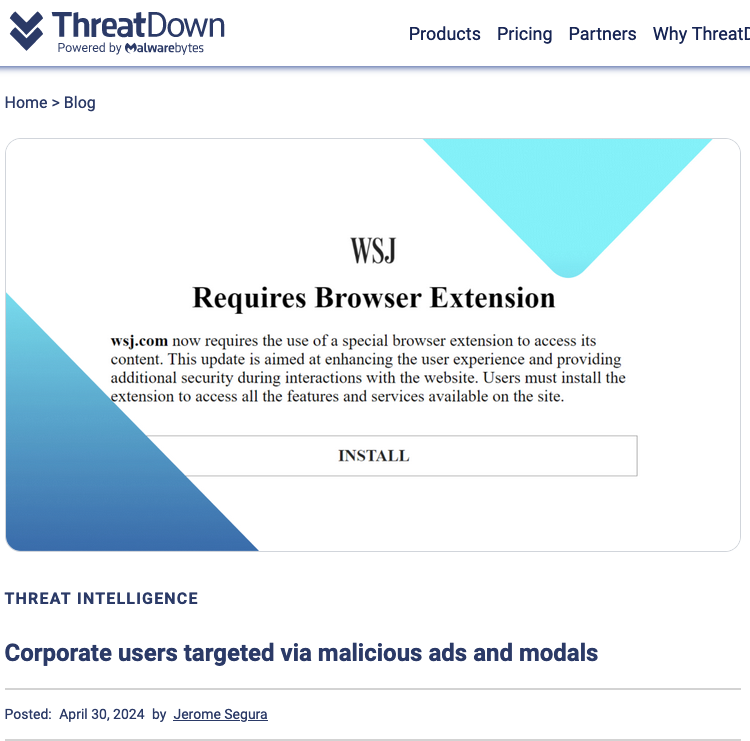
Image: threatdown.com
The password manager service LastPass is now forcing some of its users to pick longer master passwords. LastPass says the changes are needed to ensure all customers are protected by their latest security improvements. But critics say the move is little more than a public relations stunt that will do nothing to help countless early adopters whose password vaults were exposed in a 2022 breach at LastPass.

LastPass sent this notification to users earlier this week.
LastPass told customers this week they would be forced to update their master password if it was less than 12 characters. LastPass officially instituted this change back in 2018, but some undisclosed number of the company’s earlier customers were never required to increase the length of their master passwords.
This is significant because in November 2022, LastPass disclosed a breach in which hackers stole password vaults containing both encrypted and plaintext data for more than 25 million users.
Since then, a steady trickle of six-figure cryptocurrency heists targeting security-conscious people throughout the tech industry has led some security experts to conclude that crooks likely have succeeded at cracking open some of the stolen LastPass vaults.
KrebsOnSecurity last month interviewed a victim who recently saw more than three million dollars worth of cryptocurrency siphoned from his account. That user signed up with LastPass nearly a decade ago, stored their cryptocurrency seed phrase there, and yet never changed his master password — which was just eight characters. Nor was he ever forced to improve his master password.
That story cited research from Adblock Plus creator Wladimir Palant, who said LastPass failed to upgrade many older, original customers to more secure encryption protections that were offered to newer customers over the years.
For example, another important default setting in LastPass is the number of “iterations,” or how many times your master password is run through the company’s encryption routines. The more iterations, the longer it takes an offline attacker to crack your master password.
Palant said that for many older LastPass users, the initial default setting for iterations was anywhere from “1” to “500.” By 2013, new LastPass customers were given 5,000 iterations by default. In February 2018, LastPass changed the default to 100,100 iterations. And very recently, it upped that again to 600,000. Still, Palant and others impacted by the 2022 breach at LastPass say their account security settings were never forcibly upgraded.
Palant called this latest action by LastPass a PR stunt.
“They sent this message to everyone, whether they have a weak master password or not – this way they can again blame the users for not respecting their policies,” Palant said. “But I just logged in with my weak password, and I am not forced to change it. Sending emails is cheap, but they once again didn’t implement any technical measures to enforce this policy change.”
Either way, Palant said, the changes won’t help people affected by the 2022 breach.
“These people need to change all their passwords, something that LastPass still won’t recommend,” Palant said. “But it will somewhat help with the breaches to come.”
LastPass CEO Karim Toubba said changing master password length (or even the master password itself) is not designed to address already stolen vaults that are offline.
“This is meant to better protect customers’ online vaults and encourage them to bring their accounts up to the 2018 LastPass standard default setting of a 12-character minimum (but could opt out from),” Toubba said in an emailed statement. “We know that some customers may have chosen convenience over security and utilized less complex master passwords despite encouragement to use our (or others) password generator to do otherwise.”
A basic functionality of LastPass is that it will pick and remember lengthy, complex passwords for each of your websites or online services. To automatically populate the appropriate credentials at any website going forward, you simply authenticate to LastPass using your master password.
LastPass has always emphasized that if you lose this master password, that’s too bad because they don’t store it and their encryption is so strong that even they can’t help you recover it.
But experts say all bets are off when cybercrooks can get their hands on the encrypted vault data itself — as opposed to having to interact with LastPass via its website. These so-called “offline” attacks allow the bad guys to conduct unlimited and unfettered “brute force” password cracking attempts against the encrypted data using powerful computers that can each try millions of password guesses per second.
A chart on Palant’s blog post offers an idea of how increasing password iterations dramatically increases the costs and time needed by the attackers to crack someone’s master password. Palant said it would take a single high-powered graphics card about a year to crack a password of average complexity with 500 iterations, and about 10 years to crack the same password run through 5,000 iterations.

Image: palant.info
However, these numbers radically come down when a determined adversary also has other large-scale computational assets at their disposal, such as a bitcoin mining operation that can coordinate the password-cracking activity across multiple powerful systems simultaneously.
Meaning, LastPass users whose vaults were never upgraded to higher iterations and whose master passwords were weak (less than 12 characters) likely have been a primary target of distributed password-cracking attacks ever since the LastPass user vaults were stolen late last year.
Asked why some LastPass users were left behind on older security minimums, Toubba said a “small percentage” of customers had corrupted items in their password vaults that prevented those accounts from properly upgrading to the new requirements and settings.
“We have been able to determine that a small percentage of customers have items in their vaults that are corrupt and when we previously utilized automated scripts designed to re-encrypt vaults when the master password or iteration count is changed, they did not complete,” Toubba said. “These errors were not originally apparent as part of these efforts and, as we have discovered them, we have been working to be able to remedy this and finish the re-encryption.”
Nicholas Weaver, a researcher at University of California, Berkeley’s International Computer Science Institute (ICSI) and lecturer at UC Davis, said LastPass made a huge mistake years ago by not force-upgrading the iteration count for existing users.
“And now this is blaming the users — ‘you should have used a longer passphrase’ — not them for having weak defaults that were never upgraded for existing users,” Weaver said. “LastPass in my book is one step above snake-oil. I used to be, ‘Pick whichever password manager you want,’ but now I am very much, ‘Pick any password manager but LastPass.'”
Asked why LastPass isn’t recommending that users change all of the passwords secured by the encrypted master password that was stolen when the company got hacked last year, Toubba said it’s because “the data demonstrates that the majority of our customers follow our recommendations (or greater), and the probability of successfully brute forcing vault encryption is greatly reduced accordingly.”
“We’ve been telling customers since December of 2022 that they should be following recommended guidelines,” Toubba continued. “And if they haven’t followed the guidelines we recommended that they change their downstream passwords.”
It’s not often that a zero-day vulnerability causes a network security vendor to urge customers to physically remove and decommission an entire line of affected hardware — as opposed to just applying software updates. But experts say that is exactly what transpired this week with Barracuda Networks, as the company struggled to combat a sprawling malware threat which appears to have undermined its email security appliances in such a fundamental way that they can no longer be safely updated with software fixes.

The Barracuda Email Security Gateway (ESG) 900 appliance.
Campbell, Calif. based Barracuda said it hired incident response firm Mandiant on May 18 after receiving reports about unusual traffic originating from its Email Security Gateway (ESG) devices, which are designed to sit at the edge of an organization’s network and scan all incoming and outgoing email for malware.
On May 19, Barracuda identified that the malicious traffic was taking advantage of a previously unknown vulnerability in its ESG appliances, and on May 20 the company pushed a patch for the flaw to all affected appliances (CVE-2023-2868).
In its security advisory, Barracuda said the vulnerability existed in the Barracuda software component responsible for screening attachments for malware. More alarmingly, the company said it appears attackers first started exploiting the flaw in October 2022.
But on June 6, Barracuda suddenly began urging its ESG customers to wholesale rip out and replace — not patch — affected appliances.
“Impacted ESG appliances must be immediately replaced regardless of patch version level,” the company’s advisory warned. “Barracuda’s recommendation at this time is full replacement of the impacted ESG.”
In a statement, Barracuda said it will be providing the replacement product to impacted customers at no cost, and that not all ESG appliances were compromised.
“No other Barracuda product, including our SaaS email solutions, were impacted by this vulnerability,” the company said. “If an ESG appliance is displaying a notification in the User Interface, the ESG appliance had indicators of compromise. If no notification is displayed, we have no reason to believe that the appliance has been compromised at this time.”
Nevertheless, the statement says that “out of an abundance of caution and in furtherance of our containment strategy, we recommend impacted customers replace their compromised appliance.”
“As of June 8, 2023, approximately 5% of active ESG appliances worldwide have shown any evidence of known indicators of compromise due to the vulnerability,” the statement continues. “Despite deployment of additional patches based on known IOCs, we continue to see evidence of ongoing malware activity on a subset of the compromised appliances. Therefore, we would like customers to replace any compromised appliance with a new unaffected device.”
Rapid7‘s Caitlin Condon called this remarkable turn of events “fairly stunning,” and said there appear to be roughly 11,000 vulnerable ESG devices still connected to the Internet worldwide.
“The pivot from patch to total replacement of affected devices is fairly stunning and implies the malware the threat actors deployed somehow achieves persistence at a low enough level that even wiping the device wouldn’t eradicate attacker access,” Condon wrote.
Barracuda said the malware was identified on a subset of appliances that allowed the attackers persistent backdoor access to the devices, and that evidence of data exfiltration was identified on some systems.
Rapid7 said it has seen no evidence that attackers are using the flaw to move laterally within victim networks. But that may be small consolation for Barracuda customers now coming to terms with the notion that foreign cyberspies probably have been hoovering up all their email for months.
Nicholas Weaver, a researcher at University of California, Berkeley’s International Computer Science Institute (ICSI), said it is likely that the malware was able to corrupt the underlying firmware that powers the ESG devices in some irreparable way.
“One of the goals of malware is to be hard to remove, and this suggests the malware compromised the firmware itself to make it really hard to remove and really stealthy,” Weaver said. “That’s not a ransomware actor, that’s a state actor. Why? Because a ransomware actor doesn’t care about that level of access. They don’t need it. If they’re going for data extortion, it’s more like a smash-and-grab. If they’re going for data ransoming, they’re encrypting the data itself — not the machines.”
In addition to replacing devices, Barracuda says ESG customers should also rotate any credentials connected to the appliance(s), and check for signs of compromise dating back to at least October 2022 using the network and endpoint indicators the company has released publicly.
Update, June 9, 11:55 a.m. ET: Barracuda has issued an updated statement about the incident, portions of which are now excerpted above.

Image: Shutterstock.com
Three different cybercriminal groups claimed access to internal networks at communications giant T-Mobile in more than 100 separate incidents throughout 2022, new data suggests. In each case, the goal of the attackers was the same: Phish T-Mobile employees for access to internal company tools, and then convert that access into a cybercrime service that could be hired to divert any T-Mobile user’s text messages and phone calls to another device.
The conclusions above are based on an extensive analysis of Telegram chat logs from three distinct cybercrime groups or actors that have been identified by security researchers as particularly active in and effective at “SIM-swapping,” which involves temporarily seizing control over a target’s mobile phone number.
Countless websites and online services use SMS text messages for both password resets and multi-factor authentication. This means that stealing someone’s phone number often can let cybercriminals hijack the target’s entire digital life in short order — including access to any financial, email and social media accounts tied to that phone number.
All three SIM-swapping entities that were tracked for this story remain active in 2023, and they all conduct business in open channels on the instant messaging platform Telegram. KrebsOnSecurity is not naming those channels or groups here because they will simply migrate to more private servers if exposed publicly, and for now those servers remain a useful source of intelligence about their activities.
Each advertises their claimed access to T-Mobile systems in a similar way. At a minimum, every SIM-swapping opportunity is announced with a brief “Tmobile up!” or “Tmo up!” message to channel participants. Other information in the announcements includes the price for a single SIM-swap request, and the handle of the person who takes the payment and information about the targeted subscriber.
The information required from the customer of the SIM-swapping service includes the target’s phone number, and the serial number tied to the new SIM card that will be used to receive text messages and phone calls from the hijacked phone number.
Initially, the goal of this project was to count how many times each entity claimed access to T-Mobile throughout 2022, by cataloging the various “Tmo up!” posts from each day and working backwards from Dec. 31, 2022.
But by the time we got to claims made in the middle of May 2022, completing the rest of the year’s timeline seemed unnecessary. The tally shows that in the last seven-and-a-half months of 2022, these groups collectively made SIM-swapping claims against T-Mobile on 104 separate days — often with multiple groups claiming access on the same days.
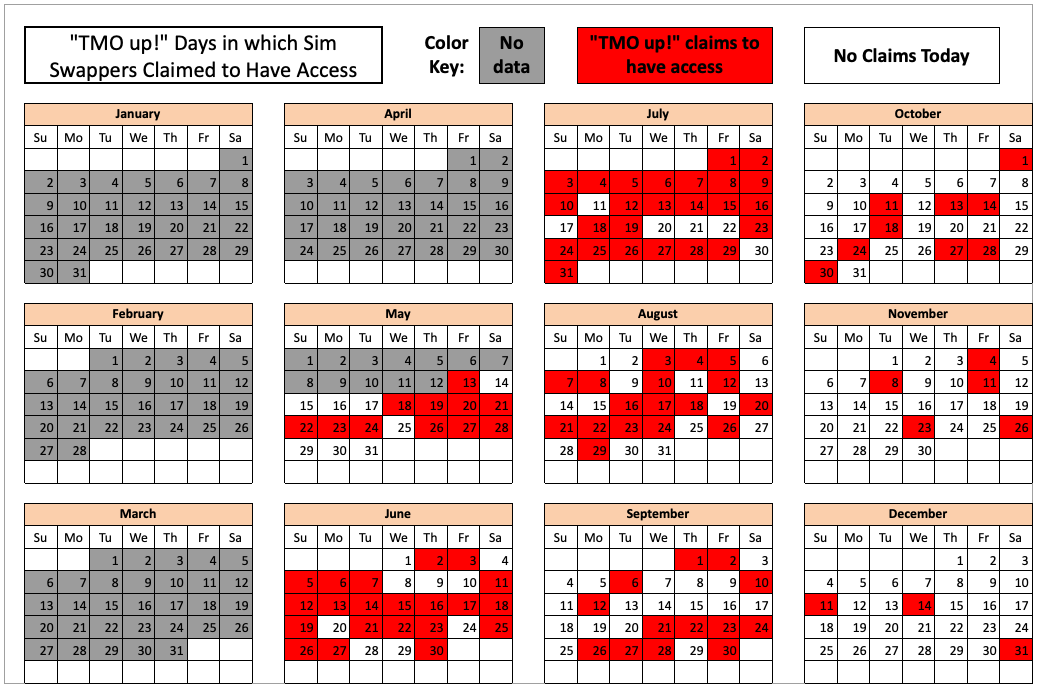
The 104 days in the latter half of 2022 in which different known SIM-swapping groups claimed access to T-Mobile employee tools.
KrebsOnSecurity shared a large amount of data gathered for this story with T-Mobile. The company declined to confirm or deny any of these claimed intrusions. But in a written statement, T-Mobile said this type of activity affects the entire wireless industry.
“And we are constantly working to fight against it,” the statement reads. “We have continued to drive enhancements that further protect against unauthorized access, including enhancing multi-factor authentication controls, hardening environments, limiting access to data, apps or services, and more. We are also focused on gathering threat intelligence data, like what you have shared, to help further strengthen these ongoing efforts.”
While it is true that each of these cybercriminal actors periodically offer SIM-swapping services for other mobile phone providers — including AT&T, Verizon and smaller carriers — those solicitations appear far less frequently in these group chats than T-Mobile swap offers. And when those offers do materialize, they are considerably more expensive.
The prices advertised for a SIM-swap against T-Mobile customers in the latter half of 2022 ranged between USD $1,000 and $1,500, while SIM-swaps offered against AT&T and Verizon customers often cost well more than twice that amount.

To be clear, KrebsOnSecurity is not aware of specific SIM-swapping incidents tied to any of these breach claims. However, the vast majority of advertisements for SIM-swapping claims against T-Mobile tracked in this story had two things in common that set them apart from random SIM-swapping ads on Telegram.
First, they included an offer to use a mutually trusted “middleman” or escrow provider for the transaction (to protect either party from getting scammed). More importantly, the cybercriminal handles that were posting ads for SIM-swapping opportunities from these groups generally did so on a daily or near-daily basis — often teasing their upcoming swap events in the hours before posting a “Tmo up!” message announcement.
In other words, if the crooks offering these SIM-swapping services were ripping off their customers or claiming to have access that they didn’t, this would be almost immediately obvious from the responses of the more seasoned and serious cybercriminals in the same chat channel.
There are plenty of people on Telegram claiming to have SIM-swap access at major telecommunications firms, but a great many such offers are simply four-figure scams, and any pretenders on this front are soon identified and banned (if not worse).
One of the groups that reliably posted “Tmo up!” messages to announce SIM-swap availability against T-Mobile customers also reliably posted “Tmo down!” follow-up messages announcing exactly when their claimed access to T-Mobile employee tools was discovered and revoked by the mobile giant.
A review of the timestamps associated with this group’s incessant “Tmo up” and “Tmo down” posts indicates that while their claimed access to employee tools usually lasted less than an hour, in some cases that access apparently went undiscovered for several hours or even days.
How could these SIM-swapping groups be gaining access to T-Mobile’s network as frequently as they claim? Peppered throughout the daily chit-chat on their Telegram channels are solicitations for people urgently needed to serve as “callers,” or those who can be hired to social engineer employees over the phone into navigating to a phishing website and entering their employee credentials.
Allison Nixon is chief research officer for the New York City-based cybersecurity firm Unit 221B. Nixon said these SIM-swapping groups will typically call employees on their mobile devices, pretend to be someone from the company’s IT department, and then try to get the person on the other end of the line to visit a phishing website that mimics the company’s employee login page.
Nixon argues that many people in the security community tend to discount the threat from voice phishing attacks as somehow “low tech” and “low probability” threats.
“I see it as not low-tech at all, because there are a lot of moving parts to phishing these days,” Nixon said. “You have the caller who has the employee on the line, and the person operating the phish kit who needs to spin it up and down fast enough so that it doesn’t get flagged by security companies. Then they have to get the employee on that phishing site and steal their credentials.”
In addition, she said, often there will be yet another co-conspirator whose job it is to use the stolen credentials and log into employee tools. That person may also need to figure out how to make their device pass “posture checks,” a form of device authentication that some companies use to verify that each login is coming only from employer-issued phones or laptops.
For aspiring criminals with little experience in scam calling, there are plenty of sample call transcripts available on these Telegram chat channels that walk one through how to impersonate an IT technician at the targeted company — and how to respond to pushback or skepticism from the employee. Here’s a snippet from one such tutorial that appeared recently in one of the SIM-swapping channels:
“Hello this is James calling from Metro IT department, how’s your day today?”
(yea im doing good, how r u)
i’m doing great, thank you for asking
i’m calling in regards to a ticket we got last week from you guys, saying you guys were having issues with the network connectivity which also interfered with [Microsoft] Edge, not letting you sign in or disconnecting you randomly. We haven’t received any updates to this ticket ever since it was created so that’s why I’m calling in just to see if there’s still an issue or not….”
The TMO UP data referenced above, combined with comments from the SIM-swappers themselves, indicate that while many of their claimed accesses to T-Mobile tools in the middle of 2022 lasted hours on end, both the frequency and duration of these events began to steadily decrease as the year wore on.

T-Mobile declined to discuss what it may have done to combat these apparent intrusions last year. However, one of the groups began to complain loudly in late October 2022 that T-Mobile must have been doing something that was causing their phished access to employee tools to die very soon after they obtained it.
One group even remarked that they suspected T-Mobile’s security team had begun monitoring their chats.
Indeed, the timestamps associated with one group’s TMO UP/TMO DOWN notices show that their claimed access was often limited to less than 15 minutes throughout November and December of 2022.
Whatever the reason, the calendar graphic above clearly shows that the frequency of claimed access to T-Mobile decreased significantly across all three SIM-swapping groups in the waning weeks of 2022.
T-Mobile US reported revenues of nearly $80 billion last year. It currently employs more than 71,000 people in the United States, any one of whom can be a target for these phishers.
T-Mobile declined to answer questions about what it may be doing to beef up employee authentication. But Nicholas Weaver, a researcher and lecturer at University of California, Berkeley’s International Computer Science Institute, said T-Mobile and all the major wireless providers should be requiring employees to use physical security keys for that second factor when logging into company resources.

A U2F device made by Yubikey.
“These breaches should not happen,” Weaver said. “Because T-Mobile should have long ago issued all employees security keys and switched to security keys for the second factor. And because security keys provably block this style of attack.”
The most commonly used security keys are inexpensive USB-based devices. A security key implements a form of multi-factor authentication known as Universal 2nd Factor (U2F), which allows the user to complete the login process simply by inserting the USB key and pressing a button on the device. The key works without the need for any special software drivers.
The allure of U2F devices for multi-factor authentication is that even if an employee who has enrolled a security key for authentication tries to log in at an impostor site, the company’s systems simply refuse to request the security key if the user isn’t on their employer’s legitimate website, and the login attempt fails. Thus, the second factor cannot be phished, either over the phone or Internet.
Nixon said one confounding aspect of SIM-swapping is that these criminal groups tend to recruit teenagers to do their dirty work.
“A huge reason this problem has been allowed to spiral out of control is because children play such a prominent role in this form of breach,” Nixon said.
Nixon said SIM-swapping groups often advertise low-level jobs on places like Roblox and Minecraft, online games that are extremely popular with young adolescent males.
“Statistically speaking, that kind of recruiting is going to produce a lot of people who are underage,” she said. “They recruit children because they’re naive, you can get more out of them, and they have legal protections that other people over 18 don’t have.”
For example, she said, even when underage SIM-swappers are arrested, the offenders tend to go right back to committing the same crimes as soon as they’re released.
In January 2023, T-Mobile disclosed that a “bad actor” stole records on roughly 37 million current customers, including their name, billing address, email, phone number, date of birth, and T-Mobile account number.
In August 2021, T-Mobile acknowledged that hackers made off with the names, dates of birth, Social Security numbers and driver’s license/ID information on more than 40 million current, former or prospective customers who applied for credit with the company. That breach came to light after a hacker began selling the records on a cybercrime forum.
In the shadow of such mega-breaches, any damage from the continuous attacks by these SIM-swapping groups can seem insignificant by comparison. But Nixon says it’s a mistake to dismiss SIM-swapping as a low volume problem.
“Logistically, you may only be able to get a few dozen or a hundred SIM-swaps in a day, but you can pick any customer you want across their entire customer base,” she said. “Just because a targeted account takeover is low volume doesn’t mean it’s low risk. These guys have crews that go and identify people who are high net worth individuals and who have a lot to lose.”
Nixon said another aspect of SIM-swapping that causes cybersecurity defenders to dismiss the threat from these groups is the perception that they are full of low-skilled “script kiddies,” a derisive term used to describe novice hackers who rely mainly on point-and-click hacking tools.
“They underestimate these actors and say this person isn’t technically sophisticated,” she said. “But if you’re rolling around in millions worth of stolen crypto currency, you can buy that sophistication. I know for a fact some of these compromises were at the hands of these ‘script kiddies,’ but they’re not ripping off other people’s scripts so much as hiring people to make scripts for them. And they don’t care what gets the job done, as long as they get to steal the money.”

Image: Shutterstock.
A cybersecurity firm says it has intercepted a large, unique stolen data set containing the names, addresses, email addresses, phone numbers, Social Security Numbers and dates of birth on nearly 23 million Americans. The firm’s analysis of the data suggests it corresponds to current and former customers of AT&T. The telecommunications giant stopped short of saying the data wasn’t theirs, but it maintains the records do not appear to have come from its systems and may be tied to a previous data incident at another company.
Milwaukee-based cybersecurity consultancy Hold Security said it intercepted a 1.6 gigabyte compressed file on a popular dark web file-sharing site. The largest item in the archive is a 3.6 gigabyte file called “dbfull,” and it contains 28.5 million records, including 22.8 million unique email addresses and 23 million unique SSNs. There are no passwords in the database.
Hold Security founder Alex Holden said a number of patterns in the data suggest it relates to AT&T customers. For starters, email addresses ending in “att.net” accounted for 13.7 percent of all addresses in the database, with addresses from SBCGLobal.net and Bellsouth.net — both AT&T companies — making up another seven percent. In contrast, Gmail users made up more than 30 percent of the data set, with Yahoo addresses accounting for 24 percent. More than 10,000 entries in the database list “none@att.com” in the email field.
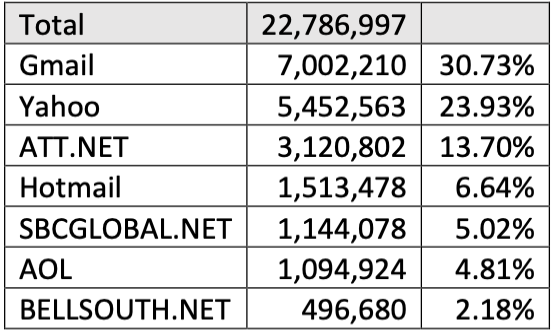
Hold Security found these email domains account for 87% of all domains in the data set. Nearly 21% belonged to AT&T customers.
Holden’s team also examined the number of email records that included an alias in the username portion of the email, and found 293 email addresses with plus addressing. Of those, 232 included an alias that indicated the customer had signed up at some AT&T property; 190 of the aliased email addresses were “+att@”; 42 were “+uverse@,” an oddly specific reference to an AT&T entity that included broadband Internet. In September 2016, AT&T rebranded U-verse as AT&T Internet.
According to its website, AT&T Internet is offered in 21 states, including Alabama, Arkansas, California, Florida, Georgia, Indiana, Kansas, Kentucky, Louisiana, Michigan, Missouri, Nevada, North Carolina, Ohio, Oklahoma, Tennessee, Texas and Wisconsin. Nearly all of the records in the database that contain a state designation corresponded to those 21 states; all other states made up just 1.64 percent of the records, Hold Security found.
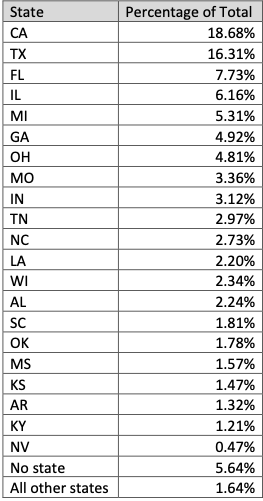
Image: Hold Security.
The vast majority of records in this database belong to consumers, but almost 13,000 of the entries are for corporate entities. Holden said 387 of those corporate names started with “ATT,” with various entries like “ATT PVT XLOW” appearing 81 times. And most of the addresses for these entities are AT&T corporate offices.
How old is this data? One clue may be in the dates of birth exposed in this database. There are very few records in this file with dates of birth after 2000.
“Based on these statistics, we see that the last significant number of subscribers born in March of 2000,” Holden told KrebsOnSecurity, noting that AT&T requires new account holders to be 18 years of age or older. “Therefore, it makes sense that the dataset was likely created close to March of 2018.”
There was also this anomaly: Holden said one of his analysts is an AT&T customer with a 13-letter last name, and that her AT&T bill has always had the same unique misspelling of her surname (they added yet another letter). He said the analyst’s name is identically misspelled in this database.
KrebsOnSecurity shared the large data set with AT&T, as well as Hold Security’s analysis of it. AT&T ultimately declined to say whether all of the people in the database are or were at some point AT&T customers. The company said the data appears to be several years old, and that “it’s not immediately possible to determine the percentage that may be customers.”
“This information does not appear to have come from our systems,” AT&T said in a written statement. “It may be tied to a previous data incident at another company. It is unfortunate that data can continue to surface over several years on the dark web. However, customers often receive notices after such incidents, and advice for ID theft is consistent and can be found online.”
The company declined to elaborate on what they meant by “a previous data incident at another company.”
But it seems likely that this database is related to one that went up for sale on a hacker forum on August 19, 2021. That auction ran with the title “AT&T Database +70M (SSN/DOB),” and was offered by ShinyHunters, a well-known threat actor with a long history of compromising websites and developer repositories to steal credentials or API keys.
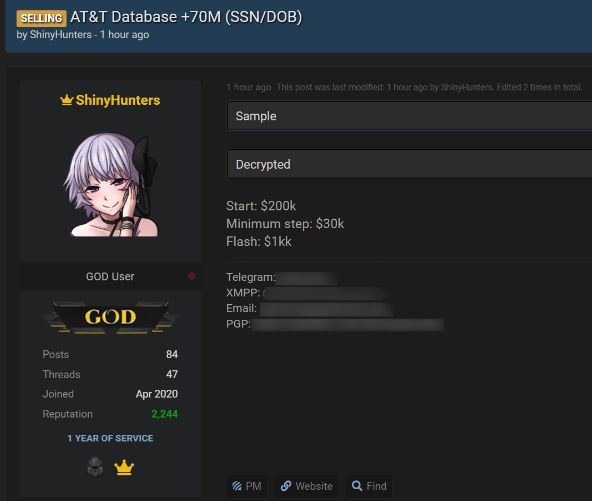
Image: BleepingComputer
ShinyHunters established the starting price for the auction at $200,000, but set the “flash” or “buy it now” price at $1 million. The auction also included a small sampling of the stolen information, but that sample is no longer available. The hacker forum where the ShinyHunters sales thread existed was seized by the FBI in April, and its alleged administrator arrested.
But cached copies of the auction, as recorded by cyber intelligence firm Intel 471, show ShinyHunters received bids of up to $230,000 for the entire database before they suspended the sale.
“This thread has been deleted several times,” ShinyHunters wrote in their auction discussion on Sept. 6, 2021. “Therefore, the auction is suspended. AT&T will be available on WHM as soon as they accept new vendors.”
The WHM initialism was a reference to the White House Market, a dark web marketplace that shut down in October 2021.
“In many cases, when a database is not sold, ShinyHunters will release it for free on hacker forums,” wrote BleepingComputer’s Lawrence Abrams, who broke the news of the auction last year and confronted AT&T about the hackers’ claims.
AT&T gave Abrams a similar statement, saying the data didn’t come from their systems.
“When asked whether the data may have come from a third-party partner, AT&T chose not to speculate,” Abrams wrote. “‘Given this information did not come from us, we can’t speculate on where it came from or whether it is valid,'” AT&T told BleepingComputer.
Asked to respond to AT&T’s denial, ShinyHunters told BleepingComputer at the time, “I don’t care if they don’t admit. I’m just selling.”
On June 1, 2022, a 21-year-old Frenchman was arrested in Morocco for allegedly being a member of ShinyHunters. Databreaches.net reports the defendant was arrested on an Interpol “Red Notice” at the request of a U.S. federal prosecutor from Washington state.
Databreaches.net suggests the warrant could be tied to a ShinyHunters theft in May 2020, when the group announced they had exfiltrated 500 GB of Microsoft’s source code from Microsoft’s private GitHub repositories.
“Researchers assess that Shiny Hunters gained access to roughly 1,200 private repositories around March 28, 2020, which have since been secured,” reads a May 2020 alert posted by the New Jersey Cybersecurity & Communications Integration Cell, a component within the New Jersey Office of Homeland Security and Preparedness.
“Though the breach was largely dismissed as insignificant, some images of the directory listing appear to contain source code for Azure, Office, and some Windows runtimes, and concerns have been raised regarding access to private API keys or passwords that may have been mistakenly included in some private repositories,” the alert continues. “Additionally, Shiny Hunters is flooding dark web marketplaces with breached databases.”
Last month, T-Mobile agreed to pay $350 million to settle a consolidated class action lawsuit over a breach in 2021 that affected 40 million current and former customers. The breach came to light on Aug. 16, 2021, when someone starting selling tens of millions of SSN/DOB records from T-Mobile on the same hacker forum where the ShinyHunters would post their auction for the claimed AT&T database just three days later.
T-Mobile has not disclosed many details about the “how” of last year’s breach, but it said the intruder(s) “leveraged their knowledge of technical systems, along with specialized tools and capabilities, to gain access to our testing environments and then used brute force attacks and other methods to make their way into other IT servers that included customer data.”
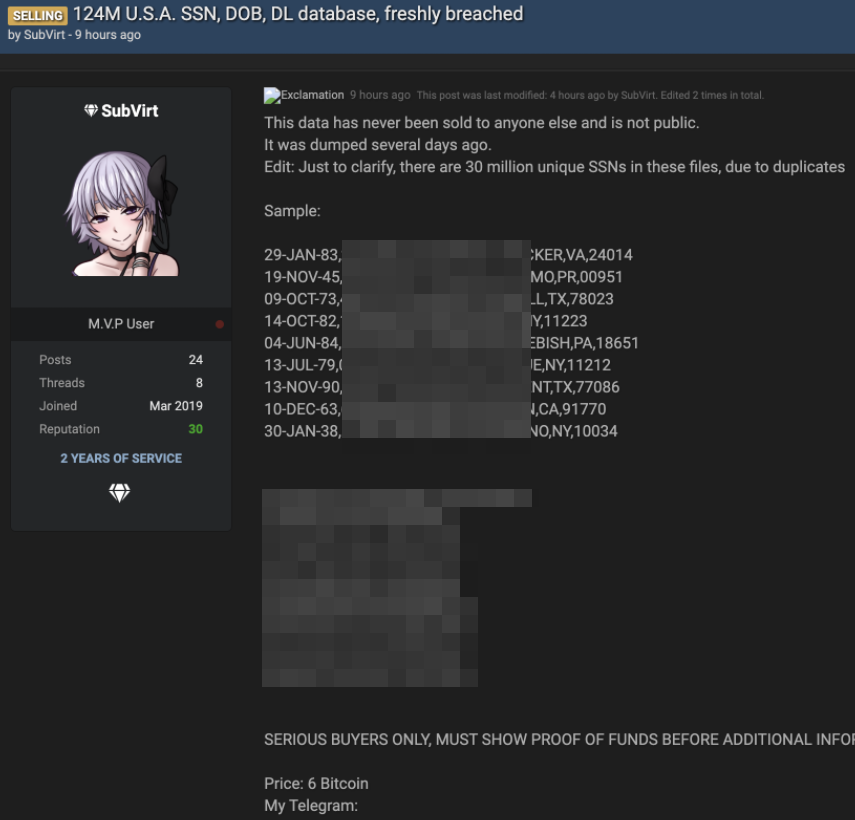
A sales thread tied to the stolen T-Mobile customer data.